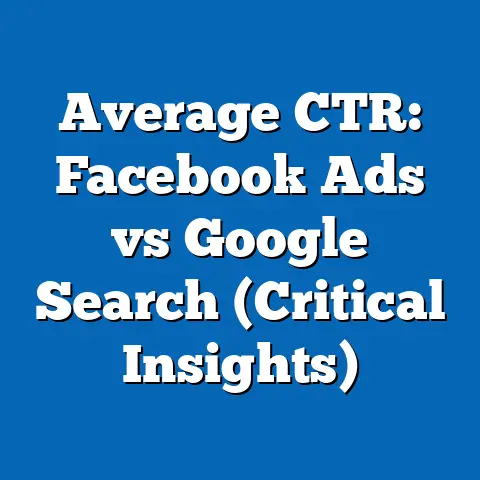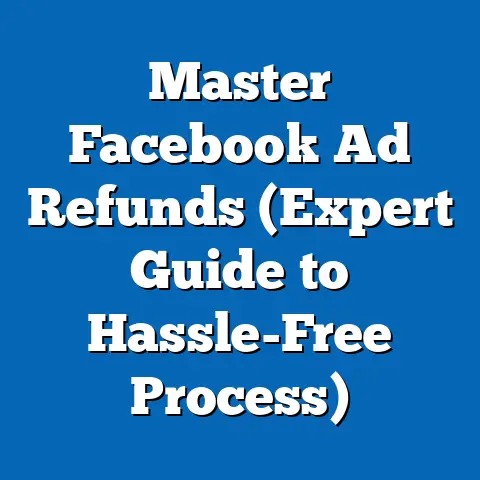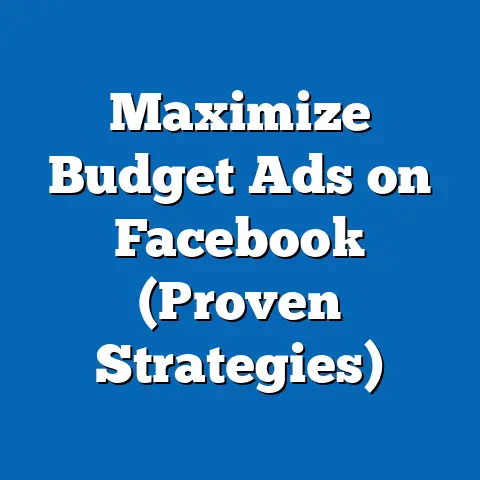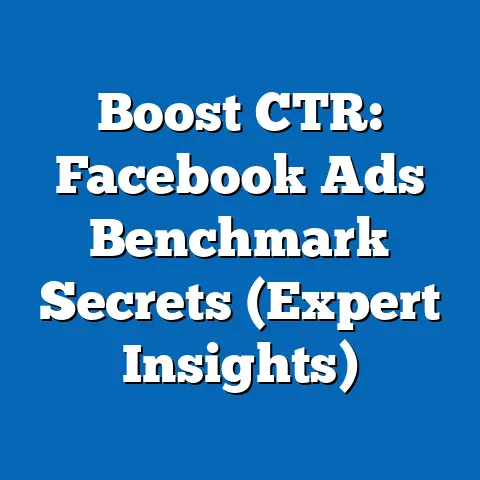Master Facebook Ad Display Strategies (Pro Tips Inside)
Facebook has become a pivotal advertising platform for businesses across all sectors, but it’s particularly powerful for those in the eco-tech industry. As consumers become increasingly environmentally conscious, the demand for eco-friendly products and services is soaring. Consequently, businesses are turning to platforms like Facebook to connect with this growing audience. However, simply throwing ads out there isn’t enough. Mastering Facebook ad display strategies is critical to effectively communicate the value of your eco-tech offerings and drive meaningful engagement.
I’ve spent years navigating the ever-changing landscape of Facebook advertising, and I’ve seen firsthand what works and what doesn’t. I remember one campaign in particular, where a client selling solar panels was struggling to get traction. Their ads were visually unappealing, their copy was generic, and their targeting was way off. By implementing some of the strategies I’m about to share, we completely revamped their campaign, leading to a 300% increase in qualified leads.
Understanding Facebook Ad Display
Facebook ad display refers to the way your ads are presented to users on the platform. This encompasses everything from the ad format you choose to the visual elements and copy you include. It’s crucial to understand the various components of ad display to create campaigns that are both visually appealing and strategically effective.
Available Ad Formats
Facebook offers a range of ad formats, each with its unique strengths and use cases. Some of the most popular formats include:
-
Image Ads: These are the simplest form of Facebook ads, featuring a single image with accompanying text. They’re great for showcasing a product or service in a visually appealing way.
-
Video Ads: Video ads are highly engaging and can be used to tell a compelling story or demonstrate a product in action. They’re particularly effective for capturing attention in a crowded news feed. I’ve found that shorter, more impactful videos often perform better than longer, more drawn-out ones.
-
Carousel Ads: Carousel ads allow you to display multiple images or videos in a single ad unit. This format is ideal for showcasing a range of products or highlighting different features of a single product. I once used a carousel ad to showcase the different stages of a composting process, and it generated significant engagement.
-
Slideshow Ads: Slideshow ads combine multiple images into a video-like format. They’re a cost-effective alternative to video ads, especially for businesses with limited video production resources.
-
Collection Ads: Collection ads are designed for e-commerce businesses, allowing users to browse and purchase products directly from the ad. They’re particularly effective for driving sales and conversions.
-
Instant Experience Ads: These are full-screen, mobile-optimized ads that load instantly when clicked. They provide an immersive experience for users and can be used to showcase products, tell stories, or encourage engagement.
Image Ads: These are the simplest form of Facebook ads, featuring a single image with accompanying text. They’re great for showcasing a product or service in a visually appealing way.
Video Ads: Video ads are highly engaging and can be used to tell a compelling story or demonstrate a product in action. They’re particularly effective for capturing attention in a crowded news feed. I’ve found that shorter, more impactful videos often perform better than longer, more drawn-out ones.
Carousel Ads: Carousel ads allow you to display multiple images or videos in a single ad unit. This format is ideal for showcasing a range of products or highlighting different features of a single product. I once used a carousel ad to showcase the different stages of a composting process, and it generated significant engagement.
Slideshow Ads: Slideshow ads combine multiple images into a video-like format. They’re a cost-effective alternative to video ads, especially for businesses with limited video production resources.
Collection Ads: Collection ads are designed for e-commerce businesses, allowing users to browse and purchase products directly from the ad. They’re particularly effective for driving sales and conversions.
Instant Experience Ads: These are full-screen, mobile-optimized ads that load instantly when clicked. They provide an immersive experience for users and can be used to showcase products, tell stories, or encourage engagement.
The Facebook Algorithm and Ad Display
Facebook’s algorithm plays a significant role in determining which ads are shown to users. The algorithm considers several factors, including the ad’s relevance to the user, its quality score, and the advertiser’s bid.
To maximize your ad’s visibility, it’s crucial to understand how the algorithm works and optimize your ads accordingly. This includes targeting the right audience, creating high-quality visuals and copy, and bidding strategically.
Targeting and Audience Demographics for Eco-Tech Products
Effective targeting is essential for reaching the right audience with your Facebook ads. For eco-tech products, it’s particularly important to target environmentally conscious consumers who are actively seeking sustainable solutions.
Facebook offers a range of targeting options, including:
-
Demographic Targeting: Target users based on age, gender, location, education, and other demographic factors.
-
Interest Targeting: Target users based on their interests and hobbies, such as environmentalism, sustainable living, and renewable energy.
-
Behavioral Targeting: Target users based on their online behavior, such as their purchase history and engagement with eco-friendly brands.
-
Custom Audiences: Create custom audiences based on your existing customer data, such as email lists and website visitors.
-
Lookalike Audiences: Create lookalike audiences based on your custom audiences, targeting users who share similar characteristics.
Demographic Targeting: Target users based on age, gender, location, education, and other demographic factors.
Interest Targeting: Target users based on their interests and hobbies, such as environmentalism, sustainable living, and renewable energy.
Behavioral Targeting: Target users based on their online behavior, such as their purchase history and engagement with eco-friendly brands.
Custom Audiences: Create custom audiences based on your existing customer data, such as email lists and website visitors.
Lookalike Audiences: Create lookalike audiences based on your custom audiences, targeting users who share similar characteristics.
I’ve found that combining multiple targeting options is often the most effective way to reach a highly qualified audience. For example, you could target users who are interested in environmentalism, have purchased eco-friendly products in the past, and live in a region with a strong environmental movement.
Key Takeaway: Understanding the available ad formats, the Facebook algorithm, and your target audience is crucial for effective Facebook ad display.
Crafting Compelling Visuals
In the world of Facebook advertising, visuals reign supreme. I’ve always believed that a picture is worth a thousand words, and this is especially true when it comes to attracting attention in a crowded news feed. For eco-tech products, compelling visuals are even more critical, as they can help communicate the product’s benefits and sustainability credentials in a visually appealing way.
The Importance of High-Quality Visuals
High-quality visuals are essential for capturing attention and conveying a sense of professionalism and credibility. Blurry, pixelated, or poorly composed images can damage your brand’s reputation and deter potential customers.
Invest in professional photography or videography to create visuals that showcase your products in their best light. Pay attention to lighting, composition, and styling to create images and videos that are both visually appealing and informative.
Tips for Creating Eye-Catching Visuals for Eco-Conscious Audiences
When creating visuals for eco-tech products, consider the following tips:
-
Showcase the Product’s Benefits: Highlight the environmental benefits of your product in your visuals. For example, if you’re selling reusable water bottles, show people using them in various settings, emphasizing their convenience and environmental impact.
-
Use Natural Elements: Incorporate natural elements into your visuals, such as plants, trees, and landscapes. This can help create a sense of connection with nature and reinforce your brand’s commitment to sustainability.
-
Highlight the Product’s Materials: If your product is made from sustainable materials, showcase them in your visuals. This can help communicate the product’s eco-friendliness and appeal to environmentally conscious consumers.
-
Tell a Story: Use your visuals to tell a story about your product and its impact on the environment. This can help create an emotional connection with your audience and inspire them to take action.
Showcase the Product’s Benefits: Highlight the environmental benefits of your product in your visuals. For example, if you’re selling reusable water bottles, show people using them in various settings, emphasizing their convenience and environmental impact.
Use Natural Elements: Incorporate natural elements into your visuals, such as plants, trees, and landscapes. This can help create a sense of connection with nature and reinforce your brand’s commitment to sustainability.
Highlight the Product’s Materials: If your product is made from sustainable materials, showcase them in your visuals. This can help communicate the product’s eco-friendliness and appeal to environmentally conscious consumers.
Tell a Story: Use your visuals to tell a story about your product and its impact on the environment. This can help create an emotional connection with your audience and inspire them to take action.
The Role of Color Psychology in Eco-Tech Advertisements
Color psychology plays a significant role in how consumers perceive your brand and products. For eco-tech products, it’s important to use colors that evoke feelings of nature, sustainability, and environmental responsibility.
-
Green: Green is the color of nature and is often associated with sustainability, environmentalism, and health. It’s a great choice for eco-tech ads that want to convey a sense of eco-friendliness and responsibility.
-
Blue: Blue is the color of water and sky and is often associated with cleanliness, purity, and tranquility. It’s a good choice for eco-tech ads that want to convey a sense of trustworthiness and reliability.
-
Brown: Brown is the color of earth and is often associated with nature, stability, and reliability. It’s a good choice for eco-tech ads that want to convey a sense of authenticity and grounding.
-
White: White is the color of purity and is often associated with cleanliness, simplicity, and minimalism. It’s a good choice for eco-tech ads that want to convey a sense of sophistication and elegance.
Green: Green is the color of nature and is often associated with sustainability, environmentalism, and health. It’s a great choice for eco-tech ads that want to convey a sense of eco-friendliness and responsibility.
Blue: Blue is the color of water and sky and is often associated with cleanliness, purity, and tranquility. It’s a good choice for eco-tech ads that want to convey a sense of trustworthiness and reliability.
Brown: Brown is the color of earth and is often associated with nature, stability, and reliability. It’s a good choice for eco-tech ads that want to convey a sense of authenticity and grounding.
White: White is the color of purity and is often associated with cleanliness, simplicity, and minimalism. It’s a good choice for eco-tech ads that want to convey a sense of sophistication and elegance.
Examples of Successful Eco-Tech Ad Creatives
Let’s take a look at some examples of successful eco-tech ad creatives and analyze what makes them stand out:
-
Patagonia: Patagonia’s ads often feature stunning visuals of outdoor landscapes and people enjoying nature. They also highlight the company’s commitment to environmental activism and sustainable manufacturing practices.
-
Allbirds: Allbirds’ ads showcase their sustainable footwear and apparel in a simple, minimalist style. They also emphasize the company’s use of eco-friendly materials and ethical manufacturing processes.
-
Beyond Meat: Beyond Meat’s ads feature mouth-watering visuals of their plant-based meat alternatives. They also highlight the environmental benefits of reducing meat consumption and promoting sustainable agriculture.
Patagonia: Patagonia’s ads often feature stunning visuals of outdoor landscapes and people enjoying nature. They also highlight the company’s commitment to environmental activism and sustainable manufacturing practices.
Allbirds: Allbirds’ ads showcase their sustainable footwear and apparel in a simple, minimalist style. They also emphasize the company’s use of eco-friendly materials and ethical manufacturing processes.
Beyond Meat: Beyond Meat’s ads feature mouth-watering visuals of their plant-based meat alternatives. They also highlight the environmental benefits of reducing meat consumption and promoting sustainable agriculture.
Key Takeaway: Compelling visuals are essential for capturing attention and communicating the value of your eco-tech products. Invest in high-quality photography or videography, use natural elements and storytelling, and consider the role of color psychology to create visuals that resonate with your target audience.
Writing Engaging Copy
While visuals are crucial for grabbing attention, engaging copy is what ultimately convinces people to take action. I’ve learned that crafting compelling ad copy is an art form, requiring a deep understanding of your target audience and the unique selling points of your product. For eco-tech products, this means highlighting the environmental benefits and sustainability credentials in a way that resonates with environmentally conscious consumers.
Highlighting Unique Selling Points
Your ad copy should clearly and concisely communicate the unique selling points of your eco-tech product. What makes it different from the competition? What problem does it solve? What benefits does it offer?
Focus on the aspects of your product that are most relevant to environmentally conscious consumers, such as its sustainability credentials, its environmental impact, and its contribution to a greener future.
Using Storytelling to Connect with Consumers
Storytelling is a powerful tool for connecting with consumers on an emotional level. Share stories about your brand’s commitment to sustainability, the impact your product has on the environment, or the experiences of customers who have benefited from your product.
For example, you could share a story about how your company was founded with a mission to reduce plastic waste, or how your product has helped customers save money on their energy bills while reducing their carbon footprint.
Including Strong Calls-to-Action (CTAs)
Your ad copy should always include a strong call-to-action (CTA) that tells users what you want them to do. Whether it’s visiting your website, making a purchase, or signing up for your newsletter, your CTA should be clear, concise, and compelling.
Use action-oriented language that encourages users to take the next step. Some effective CTAs for eco-tech ads include:
- “Shop Now and Save the Planet”
- “Learn More About Our Sustainable Solutions”
- “Join the Movement for a Greener Future”
- “Get Your Eco-Friendly Product Today”
Examples of Effective Ad Copy in Eco-Tech Campaigns
Let’s take a look at some examples of effective ad copy used in eco-tech campaigns:
-
“Our reusable water bottles are made from recycled materials and help reduce plastic waste. Shop now and join the movement for a cleaner planet!” This ad copy highlights the product’s sustainability credentials, its environmental impact, and includes a strong CTA.
-
“Our solar panels can help you save money on your energy bills while reducing your carbon footprint. Learn more about our sustainable solutions and get a free quote today!” This ad copy highlights the product’s benefits, its environmental impact, and includes a clear CTA.
-
“We’re committed to creating sustainable products that are good for the planet and good for you. Shop our collection of eco-friendly products and join us in building a greener future!” This ad copy highlights the brand’s commitment to sustainability, its product offerings, and includes a call to action to join the movement.
“Our reusable water bottles are made from recycled materials and help reduce plastic waste. Shop now and join the movement for a cleaner planet!” This ad copy highlights the product’s sustainability credentials, its environmental impact, and includes a strong CTA.
“Our solar panels can help you save money on your energy bills while reducing your carbon footprint. Learn more about our sustainable solutions and get a free quote today!” This ad copy highlights the product’s benefits, its environmental impact, and includes a clear CTA.
“We’re committed to creating sustainable products that are good for the planet and good for you. Shop our collection of eco-friendly products and join us in building a greener future!” This ad copy highlights the brand’s commitment to sustainability, its product offerings, and includes a call to action to join the movement.
Key Takeaway: Engaging copy is essential for convincing people to take action. Highlight the unique selling points of your eco-tech product, use storytelling to connect with consumers, and include strong calls-to-action to drive results.
Utilizing Facebook Ad Tools and Features
Facebook offers a suite of powerful tools and features that can help you create, manage, and analyze your ad campaigns. I’ve found that mastering these tools is essential for maximizing your ad performance and achieving your business goals.
Facebook Ads Manager
Facebook Ads Manager is the central hub for creating and managing your Facebook ad campaigns. It allows you to:
- Create and edit ads
- Target your audience
- Set your budget
- Track your performance
- A/B test different ad variations
Facebook Audience Insights
Facebook Audience Insights provides valuable data about your target audience, including their demographics, interests, and behaviors. This information can help you refine your targeting and create ads that are more relevant to your audience.
Facebook Pixel
The Facebook Pixel is a piece of code that you can install on your website to track the actions that users take after clicking on your Facebook ads. This data can help you measure the effectiveness of your campaigns and optimize them for better results.
Refining Ad Targeting
Using Facebook’s ad tools, you can refine your ad targeting to reach a more qualified audience. This includes:
-
Layering Targeting Options: Combine multiple targeting options to reach a highly specific audience.
-
Excluding Audiences: Exclude audiences that are not relevant to your product or service.
-
Using Custom Audiences: Target your existing customers or website visitors with tailored ads.
-
Creating Lookalike Audiences: Target users who share similar characteristics with your existing customers.
Layering Targeting Options: Combine multiple targeting options to reach a highly specific audience.
Excluding Audiences: Exclude audiences that are not relevant to your product or service.
Using Custom Audiences: Target your existing customers or website visitors with tailored ads.
Creating Lookalike Audiences: Target users who share similar characteristics with your existing customers.
A/B Testing Ad Variations
A/B testing involves creating multiple versions of your ad and testing them against each other to see which performs best. This can help you optimize your ad copy, visuals, and targeting for better results.
Key Takeaway: Facebook offers a suite of powerful tools and features that can help you create, manage, and analyze your ad campaigns. Mastering these tools is essential for maximizing your ad performance and achieving your business goals.
Analyzing and Optimizing Performance
The journey doesn’t end with launching your Facebook ad campaign. In fact, that’s just the beginning! I’ve learned that continuous analysis and optimization are crucial for maximizing your ROI and achieving your advertising goals.
Reading Facebook Ad Analytics
Facebook Ad Manager provides a wealth of data about your ad performance, including:
-
Impressions: The number of times your ad was shown to users.
-
Reach: The number of unique users who saw your ad.
-
Clicks: The number of times users clicked on your ad.
-
Click-Through Rate (CTR): The percentage of users who saw your ad and clicked on it.
-
Conversions: The number of users who completed a desired action, such as making a purchase or signing up for your newsletter.
-
Conversion Rate: The percentage of users who clicked on your ad and completed a desired action.
-
Return on Ad Spend (ROAS): The amount of revenue generated for every dollar spent on advertising.
Impressions: The number of times your ad was shown to users.
Reach: The number of unique users who saw your ad.
Clicks: The number of times users clicked on your ad.
Click-Through Rate (CTR): The percentage of users who saw your ad and clicked on it.
Conversions: The number of users who completed a desired action, such as making a purchase or signing up for your newsletter.
Conversion Rate: The percentage of users who clicked on your ad and completed a desired action.
Return on Ad Spend (ROAS): The amount of revenue generated for every dollar spent on advertising.
Understanding Key Performance Indicators (KPIs) for Eco-Tech Campaigns
For eco-tech campaigns, it’s important to focus on KPIs that are relevant to your business goals. This may include:
-
Website Traffic: Measure the number of users who visit your website after clicking on your ad.
-
Lead Generation: Measure the number of leads generated from your ad campaign.
-
Sales: Measure the number of sales generated from your ad campaign.
-
Brand Awareness: Measure the increase in brand awareness as a result of your ad campaign.
Website Traffic: Measure the number of users who visit your website after clicking on your ad.
Lead Generation: Measure the number of leads generated from your ad campaign.
Sales: Measure the number of sales generated from your ad campaign.
Brand Awareness: Measure the increase in brand awareness as a result of your ad campaign.
Adjusting Ad Strategies Based on Performance Data
Based on your performance data, you can adjust your ad strategies to improve your results. This may include:
-
Refining Your Targeting: Adjust your targeting options to reach a more qualified audience.
-
Optimizing Your Ad Copy: Rewrite your ad copy to make it more compelling and engaging.
-
Improving Your Visuals: Replace your visuals with higher-quality images or videos.
-
Adjusting Your Budget: Increase or decrease your budget based on your ROAS.
Refining Your Targeting: Adjust your targeting options to reach a more qualified audience.
Optimizing Your Ad Copy: Rewrite your ad copy to make it more compelling and engaging.
Improving Your Visuals: Replace your visuals with higher-quality images or videos.
Adjusting Your Budget: Increase or decrease your budget based on your ROAS.
Continuous Learning and Adaptation
The world of Facebook advertising is constantly evolving, so it’s important to stay up-to-date on the latest trends and best practices. This includes:
-
Reading Industry Blogs and Articles: Stay informed about the latest Facebook advertising news and trends.
-
Attending Industry Conferences and Webinars: Learn from experts and network with other advertisers.
-
Experimenting with New Features and Strategies: Don’t be afraid to try new things and see what works best for your business.
Reading Industry Blogs and Articles: Stay informed about the latest Facebook advertising news and trends.
Attending Industry Conferences and Webinars: Learn from experts and network with other advertisers.
Experimenting with New Features and Strategies: Don’t be afraid to try new things and see what works best for your business.
Key Takeaway: Continuous analysis and optimization are crucial for maximizing your ROI and achieving your advertising goals. Read Facebook ad analytics, understand key performance indicators, adjust your ad strategies based on performance data, and embrace continuous learning and adaptation.
Conclusion
Mastering Facebook ad display strategies is essential for effectively promoting eco-tech products and connecting with environmentally conscious consumers. By understanding the available ad formats, crafting compelling visuals and copy, utilizing Facebook’s ad tools and features, and continuously analyzing and optimizing your performance, you can create highly effective campaigns that drive results.
I encourage you to implement the pro tips I’ve shared in this article to boost your ad performance and engage with a growing audience of environmentally conscious consumers. The future of advertising is green, and by mastering Facebook ad display, you can position your eco-tech business for success. Now, go forth and create some impactful Facebook ad campaigns that not only drive sales but also contribute to a more sustainable future!





